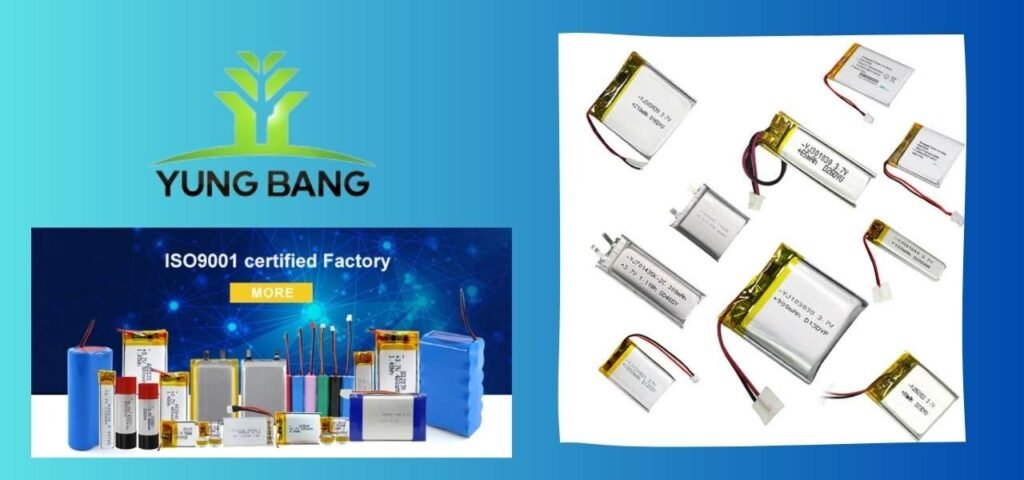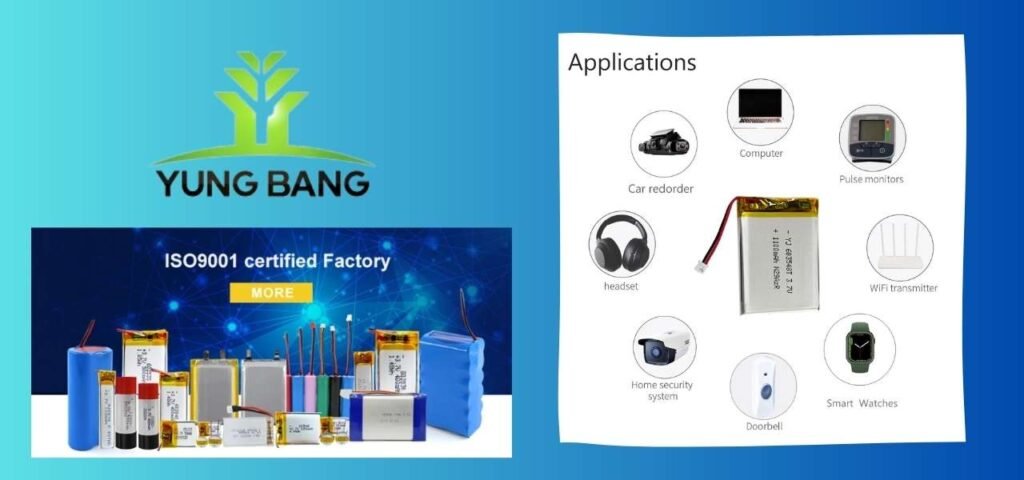1.What is a lithium battery 3.7V?
“Battery lithium 3.7V” refers to a type of lithium battery with a rated voltage of 3.7 volts (or 3.7V). This type of battery is typically a variant of lithium-ion batteries, known for their high energy density and long cycle life. They are widely used in devices such as smartphones, tablets, digital cameras, portable electronic devices, and drones.
2.How is battery lithium 3.7V produced?
(1) Raw material preparation: Key raw materials for producing 3.7V lithium-ion batteries include positive electrode materials (such as lithium cobalt oxide, lithium iron phosphate, etc.), negative electrode materials (such as graphite, silicon), electrolytes (usually organic solutions such as carbonates or polymer electrolytes), as well as conductive agents, binders, etc. These raw materials need to undergo strict screening and preparation to ensure battery performance and stability.
(2) Electrode preparation: The positive and negative electrodes are the core components of 3.7V lithium-ion batteries. The positive electrode is typically made by mixing positive electrode materials, conductive agents, and binders to form a slurry coated on aluminum foil or other conductive substrates. The negative electrode is similar, usually made by mixing negative electrode materials, conductive agents, and binders, coated on copper foil or other conductive substrates.
(3) Winding: Prepared positive and negative electrode sheets are stacked together with separators through a winding process. The separator is typically made of polypropylene or other polymers, with good electrolyte conductivity and isolation properties.
(4) Injection and encapsulation: The wound electrode sheets are placed into battery cases, and electrolyte solution is injected into the cases through vacuum injection. The battery case is usually made of aluminum or steel and sealed to prevent liquid leakage.
(5) Charging testing and final inspection: Completed 3.7V batteries undergo charging testing and rigorous quality inspection. Charging testing ensures that the battery charges normally and without abnormalities, while quality inspection includes visual inspection, capacity testing, cycle life testing, etc.

3.What are the types of lithium batteries that are 3.7V?
A common type of lithium battery is the 3.7V battery, typically a type of lithium-ion battery (Li-ion battery) or lithium polymer battery (LiPo battery). Here are some common types of lithium batteries with a rated voltage of 3.7V:
(1) 18650 battery: This is a common cylindrical lithium-ion battery, with a diameter of approximately 18mm and a length of approximately 65mm. It is commonly used in handheld electronic devices such as flashlights, laptop battery packs, etc.
(2) 14500 battery: This is another cylindrical lithium-ion battery, with a diameter of approximately 14mm and a length of approximately 50mm. It is smaller than the 18650 battery and is commonly used in smaller devices such as mini flashlights, mini fans, etc.
(3) AA Li-ion battery: This lithium-ion battery has a similar form factor to common alkaline AA batteries but with a voltage of 3.7V. It is typically used in devices requiring high energy density and long life, such as digital cameras, portable music players, etc.
(4) LiPo battery: Lithium polymer batteries can also be 3.7V, with various shapes and sizes, commonly used in applications requiring high discharge rates and lightweight, such as drones, RC vehicles, portable electronic devices, etc.
4.Why are these types of lithium batteries 3.7V?
These types of lithium batteries are designated as 3.7V mainly because their average voltage during charging and discharging processes is approximately within this range. The voltage characteristics of lithium-ion batteries and lithium polymer batteries are closely related to their chemical composition and operating principles.
In lithium batteries, the voltage difference between the positive and negative electrodes is achieved by the potential difference generated by ions moving inside the battery. Generally, the voltage range of lithium-ion batteries is between 3.0V and 4.2V because during discharge, lithium ions migrate from the positive electrode to the negative electrode, gradually decreasing the battery voltage until it reaches the critical point of charging and discharging (usually 3.0V), at which point the battery needs to be recharged.
However, since 3.7V is the average operating voltage of lithium batteries, and the voltage of the battery is mostly around this level during most of the time, manufacturers typically designate these lithium batteries as 3.7V to simplify specifications and as a standardized expression. Although the nominal voltage is 3.7V, the voltage of lithium batteries may vary slightly depending on the charging and discharging states during actual use.
5.What are the advantages of battery lithium 3.7V?
(1) High energy density: Lithium batteries typically have a high energy density, meaning they can store more energy in a smaller volume, making them lighter and more suitable for portable devices such as smartphones, laptops, etc.
(2) Lightweight design: Lithium batteries are typically lighter than traditional nickel-cadmium or nickel-metal hydride batteries, making them more convenient for use in portable devices.
(3) Stable high voltage: The nominal voltage of 3.7V means that the battery can provide relatively stable voltage output for most of its usage time, which is beneficial for the stable operation of devices.
(4) No memory effect: Lithium batteries have virtually no memory effect, meaning they do not need to be fully discharged before recharging, and they have a longer charging cycle.
(5) Lower self-discharge rate: Lithium batteries typically have a lower self-discharge rate, maintaining a higher charge state even after storage for some time.
(6) Environmental friendliness: Lithium batteries are relatively more environmentally friendly compared to traditional nickel-based batteries because they typically use more environmentally friendly materials and do not release toxic heavy metals.
6.What is the difference between battery lithium 3.7V and 3V?
The main difference between Battery lithium 3.7V and 3V lies in the voltage level and the chemical composition of the battery:
(1) Voltage level: Battery lithium 3.7V has a nominal voltage of 3.7 volts, while 3V has a nominal voltage of 3 volts. This means that the 3.7V battery has a higher voltage output.
(2) Chemical composition: Both are lithium batteries, but the specific chemical composition may differ. Typically, 3.7V lithium batteries may use lithium-ion (Li-ion) or lithium polymer (LiPo) technology, while 3V batteries may be lithium manganese batteries (LiMn), lithium sulfur batteries (Li-S), or lithium iron batteries (LiFePO4), etc.
(3) Application range: Due to the voltage difference, these batteries may have different applications in devices. Generally, 3.7V lithium batteries are used in devices with higher voltage requirements, such as portable electronic devices, digital cameras, laptops, etc., while 3V batteries are typically used in devices requiring lower voltage, such as small electronic devices, calculators, remote controls, etc.
(4) Energy storage: Due to the voltage difference, 3.7V lithium batteries typically can store more energy, making them more popular in some high-power devices.

7.What is the difference between battery lithium 3.7V and 3.5V?
The main difference between Battery lithium 3.7V and 3.5V lies in the voltage level:
(1) Voltage level: Battery lithium 3.7V has a nominal voltage of 3.7 volts, while 3.5V has a nominal voltage of 3.5 volts. This means that the 3.7V battery has a slightly higher voltage output.
(2) Application range: Due to the voltage difference, these batteries may be used in different devices and applications. Generally, 3.7V lithium batteries are used in devices with higher voltage requirements, such as portable electronic devices, digital cameras, laptops, etc., while 3.5V batteries may be used in devices that require slightly lower voltage but are not suitable for 3V batteries.
(3) Energy storage: Due to the voltage difference, 3.7V lithium batteries typically can store slightly more energy, making them more popular in some devices that require higher energy density.
8.What is the difference between battery lithium 3.7V and 3.85V?
The main difference between Battery lithium 3.7V and 3.85V lies in the charging characteristics:
(1) Application range: Due to the voltage difference, these batteries may be used in different devices and applications. Generally, 3.7V lithium batteries are used in devices with higher voltage requirements, such as portable electronic devices, digital cameras, laptops, etc., while 3.85V batteries may be used in devices that require slightly higher voltage but do not require 4.2V batteries.
(2) Charging characteristics: 3.85V batteries may have a higher maximum charging voltage limit, so they require a higher charging voltage during charging. This may affect the choice of chargers and the design of charging circuits.
(3) Energy storage: Due to the voltage difference, 3.85V lithium batteries typically can store slightly more energy, making them more popular in some devices that require higher energy density.
9.What is the difference between battery lithium 3.7V and 7.4V?
The main difference between Battery lithium 3.7V and 7.4V lies in the voltage level and application range:
(1) Voltage level: Battery lithium 3.7V has a nominal voltage of 3.7 volts, while 7.4V has a nominal voltage of 7.4 volts. This means that the 7.4V battery has a higher voltage output.
(2) Battery configuration: 7.4V batteries are typically comprised of two 3.7V batteries connected in series. By connecting two 3.7V batteries in series, the output voltage can reach 7.4V.
(3) Application range: Due to the voltage difference, these batteries are typically used in different devices and applications. Battery lithium 3.7V is commonly used in devices with lower voltage requirements, such as portable electronic devices, digital cameras, handheld tools, etc. 7.4V batteries are usually used in devices with higher voltage requirements, such as some drones, RC vehicles, model aircraft, which require higher power.
(4) Charging characteristics: 7.4V batteries may have different charging characteristics compared to 3.7V batteries, requiring higher charging voltage and larger charging current.
10.What is the difference between battery lithium 3.7V and 11.1V?
The main difference between Battery lithium 3.7V and 11.1V lies in the voltage level, battery configuration, and application range:
(1) Voltage level: Battery lithium 3.7V has a nominal voltage of 3.7 volts, while 11.1V has a nominal voltage of 11.1 volts. This means that the 11.1V battery has a higher voltage output.
(2) Battery configuration: 11.1V batteries are typically comprised of three 3.7V batteries connected in series. By connecting three 3.7V batteries in series, the output voltage can reach 11.1V.
(3) Application range: Due to the voltage difference, these batteries are typically used in different devices and applications. Battery lithium 3.7V is commonly used in devices with lower voltage requirements, such as portable electronic devices, digital cameras, handheld tools, etc. 11.1V batteries are usually used in devices with higher voltage requirements, such as some remote-controlled models, drones, power tools, etc., which require greater power.
11.What is the difference between battery lithium 3.7V and 14.8V?
The main difference between Battery lithium 3.7V and 14.8V lies in the voltage level, battery configuration, and charging characteristics:
(1) Voltage level: Battery lithium 3.7V has a nominal voltage of 3.7 volts, while 14.8V has a nominal voltage of 14.8 volts. This means that the 14.8V battery has a higher voltage output.
(2) Battery configuration: 14.8V batteries are typically comprised of four 3.7V batteries connected in series. By connecting four 3.7V batteries in series, the output voltage can reach 14.8V.
(3) Charging characteristics: 14.8V batteries may have different charging characteristics compared to 3.7V batteries, requiring higher charging voltage and larger charging current.
12.How to identify a 3.7V lithium battery
To identify whether a lithium battery is 3.7V, you can check its label or packaging for specification details, which typically clearly display the voltage. Additionally, you can confirm by:
(1) Markings and labels: Check for voltage indications on the battery’s markings and labels. Usually, 3.7V lithium batteries will have their voltage level specified on the label.
(2) Battery casing: Some batteries have voltage information engraved on their casing. You can inspect the external structure of the battery for any voltage markings.
(3) Battery specification sheet: If available, you can refer to the battery’s specification sheet or product manual. These documents usually provide detailed information about the battery voltage.
(4) Voltage measurement: If you have a multimeter or voltmeter, you can use it to measure the battery voltage. Note that the actual voltage of the battery may vary slightly above or below its nominal voltage, so fluctuations within a normal range are acceptable.
(5) Asking a salesperson: If you’re purchasing the battery in a store, you can inquire with the salesperson about the battery’s voltage level.

13.How to choose a Battery lithium 3.7V
Choosing the right 3.7V lithium battery can be based on your specific needs and application scenarios. Here are some factors to consider when selecting a battery:
Capacity requirement: Capacity determines the battery’s energy storage, usually measured in milliampere-hours (mAh). If you need the battery to last longer, you may choose a battery with a higher capacity.
Current requirement: If your device requires high current output, such as power tools or high-power devices, you may need to choose a battery with a higher discharge rate.
Size and shape: Batteries come in different sizes and shapes, such as 18650, AA, AAA, etc. Ensure that the chosen battery is compatible with your device and fits within your application space.
Quality and brand: Choosing batteries from reputable brands typically ensures better quality and performance assurance. Avoid purchasing cheap and unbranded batteries to prevent safety issues.
Charging performance: Consider the battery’s charging performance, including charging speed and cycle life. Some batteries may support fast charging technology, which can save charging time.
Environmental adaptability: If your device will operate in harsh environmental conditions, such as high or low temperatures, you may need to choose a battery with good environmental adaptability.
Safety considerations: Ensure that the chosen battery has appropriate safety features, such as overcharge protection, over-discharge protection, and short circuit protection, to reduce the occurrence of accidents.
Cost considerations: Lastly, consider your budget and cost requirements. High-quality batteries usually come at a higher price but can provide longer lifespan and better performance.
14.Yungbang’s Battery lithium 3.7V
Guangdong Yungbang New Energy Co., Ltd. was established in June 2013. Currently, we have a factory covering an area of 18,000 square meters and more than 500 employees. We have multiple independent intellectual property rights and have been recognized as a national high-tech enterprise specializing in the research, development, design, production, and sales of 3.7V lithium-ion battery cells and battery packs.
Our Battery lithium 3.7V products are widely used in various fields such as mobile phones, tablets, laptops, smart wearable devices, power tools, and automotive equipment. Over the years, we have established a comprehensive quality management system and obtained UL, PSE, CQC, ISO9001, ISO14001, CE, FCC, United Nations, and other certifications. All products comply with EU RoHS standards.

